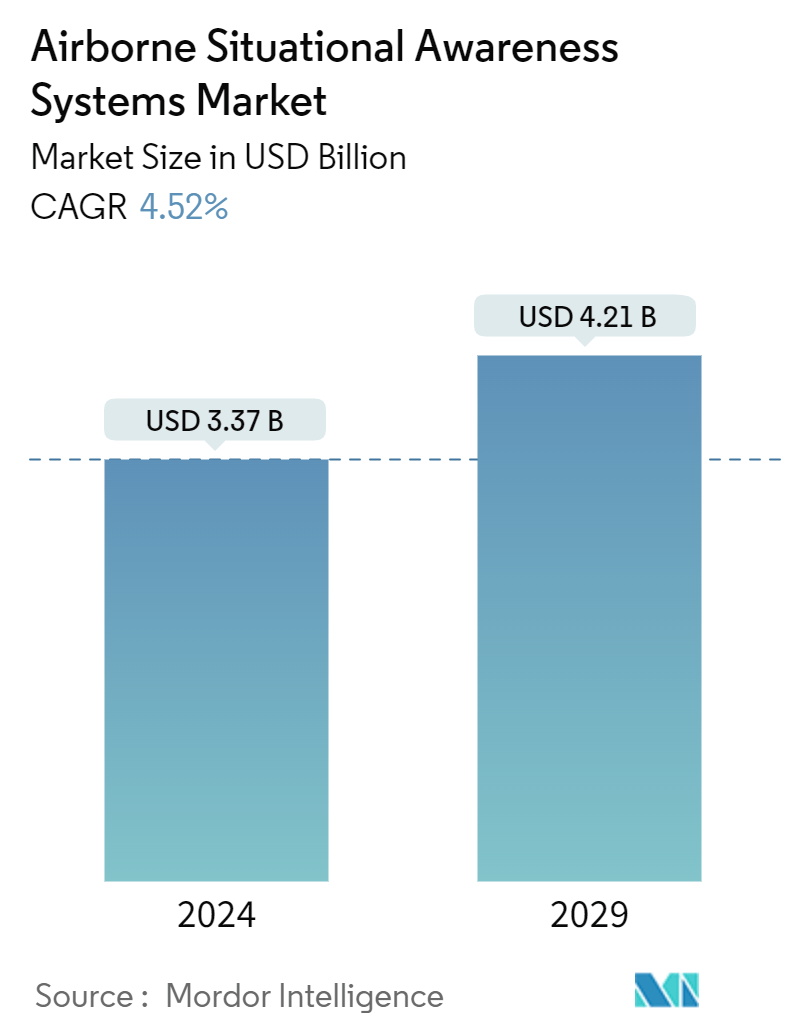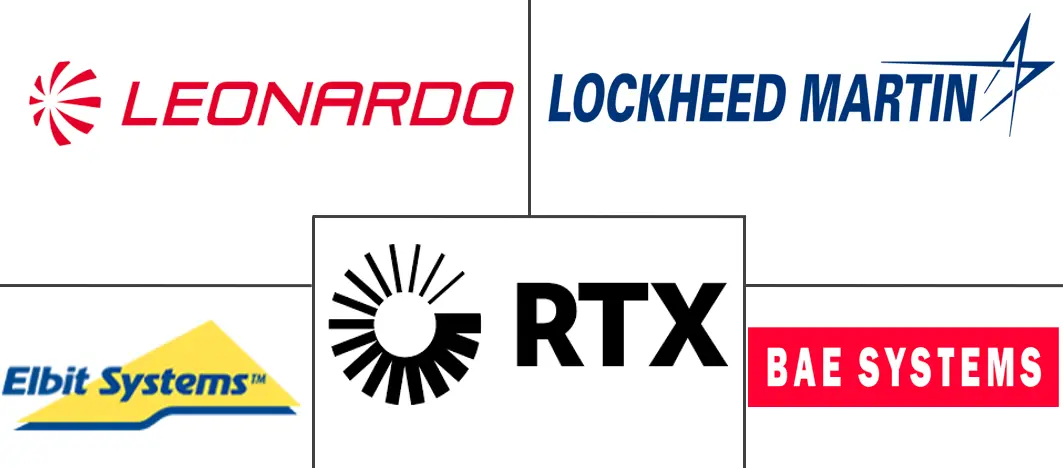Market Size of Airborne Situational Awareness Systems Industry

| Study Period | 2019 - 2029 |
| Market Size (2024) | USD 3.37 Billion |
| Market Size (2029) | USD 4.21 Billion |
| CAGR (2024 - 2029) | 4.52 % |
| Fastest Growing Market | Asia Pacific |
| Largest Market | North America |
| Market Concentration | Low |
Major Players
*Disclaimer: Major Players sorted in no particular order |
Airborne Situational Awareness Systems Market Analysis
The Airborne Situational Awareness Systems Market size is estimated at USD 3.37 billion in 2024, and is expected to reach USD 4.21 billion by 2029, at a CAGR of 4.52% during the forecast period (2024-2029).
Governments are ramping up military spending, driven by rising terrorism, international tensions, illicit trade, border skirmishes, and the advent of advanced technologies like anti-aircraft missile systems and electronic warfare. This surge in military investment aims to bolster the air superiority of existing fleets, enhancing capabilities in combat, intelligence, surveillance, and reconnaissance operations. Consequently, there's a growing global demand for airborne situational awareness systems.
There's a heightened emphasis on miniaturization and accuracy in ISR systems and their payloads, leading to widespread adoption across various platforms. Their reliability and cost-effectiveness have prompted militaries to procure these systems extensively. With the emergence of new threats, the significance of these systems in military preparedness has only intensified.
Technological advancements are ushering in disruptive innovations within the defense sector. There's a concerted effort to integrate AI and machine learning into airborne situational awareness platforms. Given the importance of situational awareness in ISR missions, challenges arise from the vast data volumes and complexities of fusion and aggregation, hindering processing speeds and overall effectiveness.
Airborne Situational Awareness Systems Industry Segmentation
Aerial forces rely on advanced airborne situational awareness systems, such as radar, lidar, infrared sensors, etc., to continuously monitor the airspace for potential threats posed by adversaries. These sophisticated systems also enable them to assess the status of their aircraft, including engine performance, fuel levels, and overall operational readiness, ensuring they can respond effectively to any situation.
The airborne situational awareness systems market is segmented based on component, type, and geography. The market is segmented into sensors, display notification systems, and other components (notification and display systems and command and control systems). Based on type, the market is segmented into command and control, radars, optronics, and other types (high-resolution cameras and advanced data analytics software). The report also covers the market sizes and forecasts for the airborne situational awareness systems market in major countries across different regions. For each segment, the market size is provided in terms of value (USD).
| Component | |
| Sensors | |
| Displays and Notification Systems | |
| Other Components |
| Type | |
| Command and Control | |
| RADARs | |
| Optronics | |
| Other Types |
| Geography | |||||||
| |||||||
| |||||||
| |||||||
| |||||||
|
Airborne Situational Awareness Systems Market Size Summary
The airborne situational awareness systems market is experiencing significant growth, driven by increasing global military expenditures due to rising terrorism, geopolitical tensions, and the need for enhanced air superiority. Governments are investing in advanced systems to bolster their air force capabilities for combat, intelligence, surveillance, and reconnaissance operations. The demand for these systems is further fueled by the focus on miniaturization and improved accuracy of ISR systems, which are becoming integral to military preparedness. Rapid technological advancements, including the integration of AI and machine learning, are enhancing the capabilities of these systems, making them crucial for decision-making in complex ISR missions. The growing need for electronic warfare equipment and sensor-based radar systems is also contributing to market expansion, as countries seek to protect their airborne assets from sophisticated threats.
In the Asia-Pacific region, countries like China, India, and Japan are significantly increasing their military spending to develop and procure advanced airborne situational awareness systems. This growth is driven by geopolitical tensions and the need to enhance maritime and aerial border security. Local manufacturing initiatives and technology transfer agreements are further supporting the development of new-generation military fighters with advanced capabilities. The market is characterized by high competition, with major players like Lockheed Martin, BAE Systems, and Elbit Systems investing heavily in R&D to incorporate cutting-edge technologies. Partnerships and collaborations are facilitating technology transfer and mutual growth among industry players. The market's fragmented nature and the entry of new players with innovative solutions are expected to intensify competition and drive further advancements in airborne situational awareness systems.
Airborne Situational Awareness Systems Market Size - Table of Contents
-
1. MARKET DYNAMICS
-
1.1 Market Overview
-
1.2 Market Drivers
-
1.3 Market Restraints
-
1.4 Porter's Five Force Analysis
-
1.4.1 Threat of New Entrants
-
1.4.2 Bargaining Power of Buyers/Consumers
-
1.4.3 Bargaining Power of Suppliers
-
1.4.4 Threat of Substitute Products
-
1.4.5 Intensity of Competitive Rivalry
-
-
-
2. MARKET SEGMENTATION
-
2.1 Component
-
2.1.1 Sensors
-
2.1.2 Displays and Notification Systems
-
2.1.3 Other Components
-
-
2.2 Type
-
2.2.1 Command and Control
-
2.2.2 RADARs
-
2.2.3 Optronics
-
2.2.4 Other Types
-
-
2.3 Geography
-
2.3.1 North America
-
2.3.1.1 United States
-
2.3.1.2 Canada
-
-
2.3.2 Europe
-
2.3.2.1 Germany
-
2.3.2.2 United Kingdom
-
2.3.2.3 France
-
2.3.2.4 Russia
-
2.3.2.5 Rest of Europe
-
-
2.3.3 Asia-Pacific
-
2.3.3.1 China
-
2.3.3.2 India
-
2.3.3.3 Japan
-
2.3.3.4 South Korea
-
2.3.3.5 Rest of Asia-Pacific
-
-
2.3.4 Latin America
-
2.3.4.1 Brazil
-
2.3.4.2 Rest of Latin America
-
-
2.3.5 Middle East and Africa
-
2.3.5.1 United Arab Emirates
-
2.3.5.2 Saudi Arabia
-
2.3.5.3 Israel
-
2.3.5.4 Rest of Middle East and Africa
-
-
-
Airborne Situational Awareness Systems Market Size FAQs
How big is the Airborne Situational Awareness Systems Market?
The Airborne Situational Awareness Systems Market size is expected to reach USD 3.37 billion in 2024 and grow at a CAGR of 4.52% to reach USD 4.21 billion by 2029.
What is the current Airborne Situational Awareness Systems Market size?
In 2024, the Airborne Situational Awareness Systems Market size is expected to reach USD 3.37 billion.

